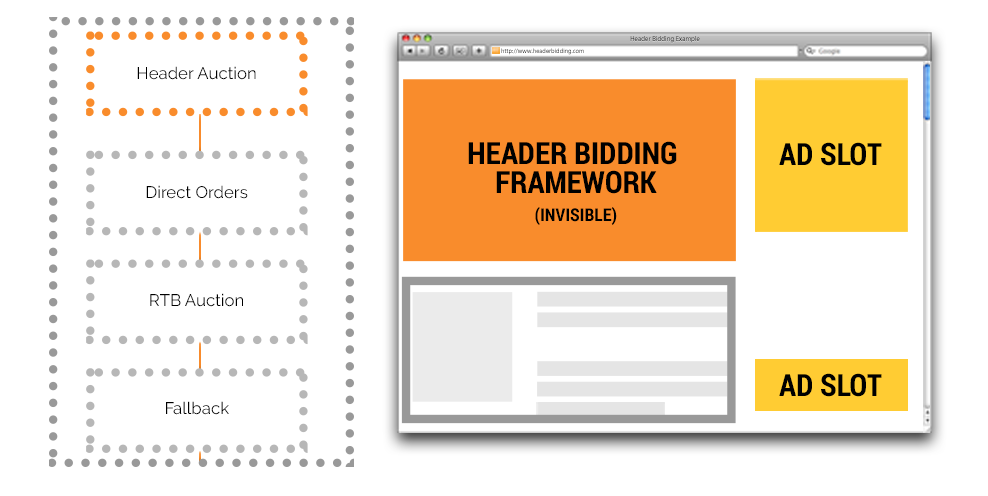Understanding Header Bidding –AdTech’s Newest Desired Skill


Header Bidding 101
Publishers, programmatic-centric organizations and advertisers are in universal agreement that header bidding is the next big step in online auction systems. With a 252% year over year increase in mobile web impressions due to header bidding and its continuous growth in the global market, needless to say header bidding is here to stay. But, though the term gets thrown around within the ad-tech world from our clients or our candidates, what exactly is header bidding anyways?
In short, header bidding takes a different approach to the typical waterfall / RTB auction advertising model that was commonly used among publishers with complaints. Where issues lied within the waterfall model is in its inability to optimize ad inventory based on pricing. Marketers within the RTB model also had grievances about the “race-to-the-bottom” model that was initiated with the traditional auction model, pursuing inventory that is considered unwanted. In the Header Bidding model, publishers place code from their SSP (supply-side-partner) within the header of the site. This invisible auction at the beginning of the site’s load time allows for greater transparency for RTB or programmatic buyers, an increase in demand range / variety, an increase in accessible inventory and more efficiency in yield management.

Header bidding’s technology relies heavily on the JavaScript within the code of the publisher’s header. Within the process, a user will visit the web page which will load the header bidding framework along with each header bidding partner’s script. The script sends the opportunity to the demand partner, receives the response and selects the winners based on the auction. Once the winner is selected and the tags instruct the server on line item price point, the request is returned to the site and the inventory spot is filled.
From an initial testing point of view, publishers are still experimenting with their SSP, demand partners and their development team as to the number of header bidders within their site, integrations and ad server tags. While we are still in the early stages of header bidding, with issues of data leakage, malvertising and latency being discussed among sales, ad ops, marketing and development teams alike, it is safe to say that header bidding will continue to dominate as the main model for publisher’s advertising models.
So, what does header bidding mean for you? As more and more publisher, adtech, and digital media companies are increasing their teams to include header bidding knowledgeable talent, understanding this stride in technology can be the breaking point between you and your next role.
What You Will Need To Know
For Ad Ops/ Developers: There are various players in the header bidding market who are making the initial movements in the space. Prebid.js is the main tool utilized by developers in terms of implementing header bidding into a publisher’s website. Launched in 2015, this open source library is the most widely used Header Bidding “container” or “wrapper,” and the ecosystem with the most demand partners, publishers and analytics providers. Other organizations, in-house proprietary and third party, have solutions and technology that is continuing to enter the adverting technology landscape each and every day. If your organization is considering a Header Bidding solution, or if you are looking to enter a new organization with developing header bidding strategies, you might want to consider the pros and cons of each major tool used to undergo header bidding.

For Marketers: With the changes involved with header bidding and the availability of new inventory, publishers see this as a means of increasing the revenue. At what cost? Expect the cost of header bidding publisher brand ad inventory so increase the more competition within this model increases. As demand side platforms see an increase in weight through the header bidding model while the amount of inventory remains the same, bid requests soar while the infrastructure within these demand partners begin to crumble from weight. For marketers and advertisers, in house or agency, having the initial conversations with stakeholders and clients about the increasing costs of CPMs for display ads, changes in auction practices and overall ad performance is your best bet for preparing for header bidding to take majority market share for advertising models. Internally, your team should discuss changes in bidding strategies, ad practices and the partnerships you have made within your organization. If you are looking to transition into a new marketing or advertising role, make sure to question a prospective employers current strategy for tackling header bidding ad practices.

Graph courtesy of E-Marketer
For Sales: Sellers looking for opportunities to sell header bidding solutions should have a deep understanding of the current state of the market. When header bidding was launched in 2015, many major advertising organizations created their own commoditized solution, such as Google’s Exchange Bidding, AppNexus’ PreBid Enterprise, and OpenX’s Header Bidding solution. If you are currently within a sales position which is in the early stages of developing strategy for header bidding solutions, make sure to engage the conversation with your Product team before it’s too late. Keep yourself informed with the latest developments in header bidding and see if your organization is attuned to handle the changes.
If you are looking to make a transition in your career into a role with header bidding options, coming out of a company with no such solutions, make sure you have a firm understanding of the differences in the market. While the concept of header bidding are relatively simple from a broad perspective, understanding the intricacies of header bidding solutions will give you a better understanding of if a particular companies solutions are aligned with your sales strategies. Before you start looking into adtech or publisher organizations with Header Bidding solutions, ask some of the following questions.
- Does the company provide Browser to Browser Header Bidding (Where the JavaScript is embedded in the page itself) or Server to Server (Where the auction takes in the “cloud”)?
- Does a company’s Header Bidding solution have notable use cases of increasing latency and if so, what are they doing to resolve these issues?
- What are a publisher’s / agency’s reasons for shifting from waterfall to header bidding, and how will a companies solutions align with their goals?
In Short…
Header bidding represents a major progression in the digital advertising landscape that ultimately affects publishers, advertisers and the sales, marketing, ad ops, development, product and senior management teams who keep them all running. Though the industry is still in the early stages of on boarding and implementing header bidding, continuing to keep track of this new option will make you a diamond in the rough when it comes to looking for new career opportunities.
Make sure to download our one page overview of header bidding below!
